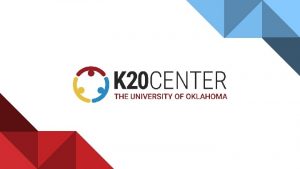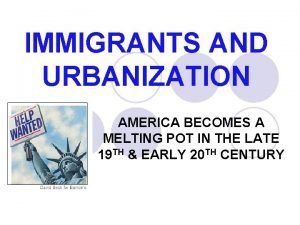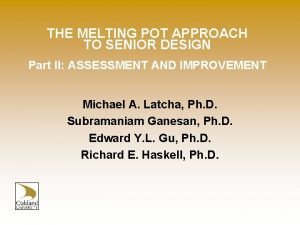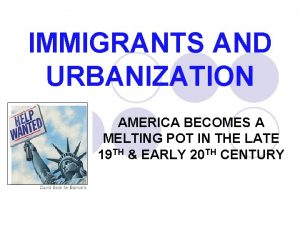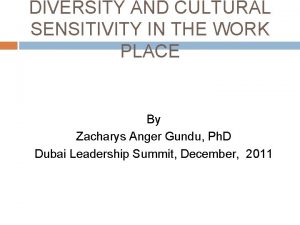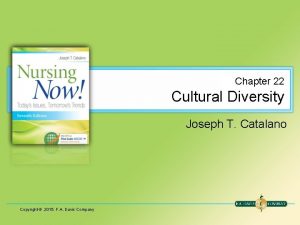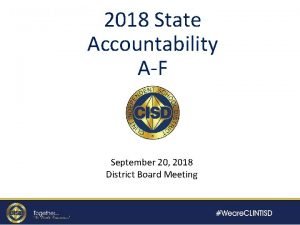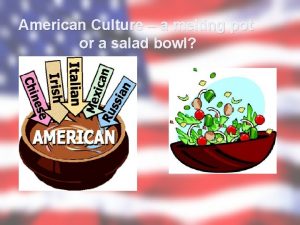Melting Pot Meets Tossed Salad A Historical Examination
















![African-Centered Pedagogy: “…incorporat[es] more than language and communicative style, more than interactional competence, to African-Centered Pedagogy: “…incorporat[es] more than language and communicative style, more than interactional competence, to](https://slidetodoc.com/presentation_image/0ee2217721cc9d9e261db442c440f132/image-17.jpg)




- Slides: 21

Melting Pot Meets Tossed Salad: A Historical Examination of Culturally Relevant Pedagogy Valerie Nyberg Curriculum and Instruction Language, Literacy, and Culture Ph. D.

Shirley Brice Heath Ways With Words Ethnography that emphasized the importance of understanding how children approach and use language based on the values and experiences within the home and immediate community n Emphasize how and why those early experiences strongly relate to school performance n

Specifically, Heath studied: Roadville: all-white working-class community n Trackton: all-Black working class community n Townspeople: middle-class (Black and White) community n

Heath found: n n Primarily Heath studied the differences between the White working-class and the Black working class communities and compared them to the White and Black middle class community From birth, each community not only had a different orientations to children (i. e. babies were seen as conversationalists vs. as “coming to know”), but they valued reading, writing, and speaking differently Early childhood experiences included learning to negotiate absorb specific habits (i. e. what constituted as a story, how to tell it, in what circumstances, etc. ) and use them accordingly Child rearing practices were usually uniformed throughout the communities studied

Specifically, Heath studied: n Roadville: all-white community workingclass community Mothers used baby talk n Parents emphasized using the “right word” and telling stories in the “right order” n Stories told needed to convey “factual” information and illustrate a learned lesson or have a clear meaning n Reading and writing, although valued, were only minimally used n Time regimented/spaces clearly demarcated n

She also studied: n Trackton: all-Black working class community Babies and children were talked about, but rarely spoken to n Baby utterances ignored; adults were knowledge holders; children “came to know” n Stories incorporated made up or fantasy elements n Words used for multiple contexts; meaning/ interpretation depended on intonation, voice, etc. ; meaning is implicit n Time is of little value; spaces are not clearly defined n Reading was a social event, meaning negotiated through everyone’s personal experiences; writing was always linked to talking n

Heath then compared these to: n Townspeople: middle-class (Black and White) community n n n Children initiated into a literate world—surrounded by books, asked to identify and learn literate behaviors Reading and writing (for various purposes) was an integral Time was segmented into routines, spaces clearly demarcated Talking is critical; children seen as conversationalist— mothers see baby talk as intentional Fantasy encouraged, but distinguished from the “real world” Education is highly valued and stressed, parents often attended graduate classes

Impacts on school performance: n Emphasized that teachers viewed White working -class and Black working-class students differently n n n Usually Black students were seen as deficient and/or oppositional White students seen as lacking in skills, but able to learn through alternative approaches and additional help and guidance Showed that schools privileged middle-class children’s speaking and writing habits Teachers often used their own cultural habits as the primary way they approached their students By 4 th grade both Roadville and Trackton children seemed locked in a pattern of failure

Lisa Delpit Other People’s Children n Compilation of essays, articles, and speeches she has given Primary focus is on the ways in which Black and poor children are (often) unintentionally treated and regarded even though teachers may be well meaning Often misunderstood as privileging skills-based instruction over whole language, but this distinction isn’t really her focal point

Instead, Delpit talks about: n Culture of Power 1. 2. 3. 4. 5. Issues of power are enacted in the classroom. There are codes or rules for participating in power; that is, there is a “culture of power. ” The rules of the culture of power are a reflection of the rules of the culture of those who have power. If you are not already a participant in the culture of power, being told explicitly the rules of that culture makes acquiring power easier. Those with power are frequently least aware of—or least willing to acknowledge—its existence. Those with less power are often most aware of its existence. (p. 24)

In addition, Delpit emphasizes: Valuing the “native” and “home” culture in the classroom. n Highlights the misunderstandings that often with cross-cultural communications in regard to notions of: n Teacher-student-content relationship n Evaluation (similar to Heath’s findings) n Approaches to reluctant learners n

Gloria Ladson-Billings The Dreamkeepers Comes to the conversation at a time when demographics show an increasing achievement gap between Black student and their White counterparts n Emphasizes that urban Black students seem to be locked in a downward plummet n She highlights specific teachers who are able to teach in “culturally relevant” ways n

Culturally Relevant Teaching The primary aim of culturally relevant teaching is to assist in the development of a “relevant black personality” that African American students to choose academic excellence yet still identify with African and African American culture. Specifically, culturally relevant teaching is a pedagogy that empowers students intellectually, socially, emotionally, and politically by using cultural referents to impart knowledge, skills, and attitudes. These cultural referents are not merely vehicles for bridging or explaining the dominant culture; they are aspects of the curriculum in their own right. (p. 17 -18)

Culturally Relevant Teaching Principles: 1. 2. 3. 4. A view of teaching as an art where the teachers are artists. Instills the formation of a “community of learners” where the teacher-student relationship is fluid and humanely equitable; students rely on one another to share the responsibility of learning; and these relationships extend beyond the classroom into the larger community. Is based on the view of students as competent, able to succeed and where teachers demonstrate their connectedness by legitimatizing students’ real-life experiences as part of the larger “official” curriculum. Cognizant of the need to struggle against the status quo as political beings with community, national, and global identities. (pp 34, 55, 117 -118)

Making Dreams into Reality Vision of a Culturally Responsive School 1. Provide educational self-determination. ¨ The ability of the teachers, parents, and students to determine their educational goals and values versus having local, state, and federal mandates issue them 2. Honor and respect the students’ home culture. ¨ To accurately and fairly represent African American culture in the schools rather than denigrate it and/or treat it as deficient. ¨ To remember that African American children are the heirs to a great tradition of art, music, dance, science, invention, oratory, and so on. 3. Help African American students understand the world as it is and equip them to change it for the better. ¨ …to help arm African American children with the knowledge, skills, and attitude needed to struggle successfully against oppression. ¨ Equip them with “excellent skills from the basics of reading, writing, and math, to understanding history, thinking critically, solving problems, making decisions; they must go beyond merely filling in test sheet bubbles with Number 2 pencils. (pp. 138 -140)

Peter Murrell African-Centered Pedagogy n n Believes that attempts to teach urban African American have failed because they lacked sufficient emphasis of the culture and language of African Americans Much of his text is an extensive review and critique of the evolution of “culturally relevant” movement; however, along the way, he gleans a number of attributes from these and other materials form the basis of the “African-Centered Pedagogy”
![AfricanCentered Pedagogy incorporates more than language and communicative style more than interactional competence to African-Centered Pedagogy: “…incorporat[es] more than language and communicative style, more than interactional competence, to](https://slidetodoc.com/presentation_image/0ee2217721cc9d9e261db442c440f132/image-17.jpg)
African-Centered Pedagogy: “…incorporat[es] more than language and communicative style, more than interactional competence, to include a critical and reflective regard of the social, historical, and cultural positionings of teachers and students in the conjoint actions that constitute teaching and learning. ” (p. 15)

Comprised of: Seven principles based on the appropriation and application of a variety of theoretical perspectives n Five practices that integrate “social[ly], cultural[ly], historical[ly] situated system of practices that bind teachers and learners in the joint activity of learning achievement. ” (p. 37) n

Progression Overview A. Heath ¨ connecting the socio-cultural environment to the ways which children acquire specific habits of mind and ways with words ¨ demonstrated that the melting pot approach created a seemingly permanent downward spiral for working-class children B. Delpit ¨ Coined “culture of power” in order to bring attention to the need for explicitness as well as raised concerns about the need for teachers to be more culturally aware and responsive. ¨ Serves to nudge away from melting pot in order to suggest a more dimensional view (salad on the horizon) C. Ladson-Billings ¨ Coined “culturally relevant teaching” in order to suggest a tossed salad approach to teaching African American children. ¨ At this point it’s an additive approach—where melting pot meets tossed salad D. Murrell ¨ Exclusively focuses on African American children ¨ Replaces the melting pot approach in favor of an exclusively Africancentered pedagogy (tossed salad)

Implications 1. 2. 3. 4. 5. Replaces Eurocentric dominant approach with a different culture (ethnic) approach Fails to address the problems of essentializing—the notion that one focuses on core or “essential” characteristics of a group— individual students based on their race and/or imagined life histories Doesn’t do enough to challenge the status quo in regards to funding; distribution of talented, qualified teachers; as well as other issues of equality in education Deemphasizes the reality that all students bring a unique set of “multiple intellegences” and ways with words related AND unrelated to their culture By narrowing the focus on a single culture it limits how educational theorists and researchers are able to think about and approach ways of overcoming our racially and socioeconomically stratified educational system

Solutions Using Murrell’s principles and practices as a basis, difference-centered pedagogy invites students into culturally reflexive communities of inquiry. These would: ¨ Begin by acknowledging the fluid nature of identity and use this notion to consider “how the self reads itself” (Britzman 1998, p. 3). ¨ This is done in order to then interrogate these concepts of difference that exist within and between us all. ¨ Using the familiar notions of race, class, disabilities, etc. , with an emphasis of deconstructing these notions and their implications in order to create new language about identity and the self without privileging a particular culture.
 Salad bowl culture
Salad bowl culture Melting pot vs salad bowl
Melting pot vs salad bowl Contoh melting pot
Contoh melting pot Melting pot and salad bowl
Melting pot and salad bowl Guacamole
Guacamole Melting pot
Melting pot Melting pot approach
Melting pot approach Melting pot gilded age
Melting pot gilded age Oxbridge melting pot
Oxbridge melting pot Melting pot
Melting pot Tungsten melting pot
Tungsten melting pot Melting pot
Melting pot Incongruent melting phase diagram
Incongruent melting phase diagram Free fall video
Free fall video Chapter 10 projectile and satellite motion
Chapter 10 projectile and satellite motion Energy of a tossed ball lab
Energy of a tossed ball lab Chapter 10 projectile and satellite motion tossed ball
Chapter 10 projectile and satellite motion tossed ball Chapter 10 projectile and satellite motion
Chapter 10 projectile and satellite motion A ball has been tossed staight up which the correct digram
A ball has been tossed staight up which the correct digram Academia meets industry
Academia meets industry How does huck rediscover jim
How does huck rediscover jim Approaches meets masters
Approaches meets masters
